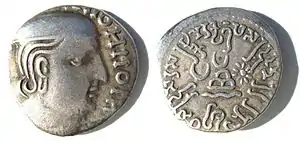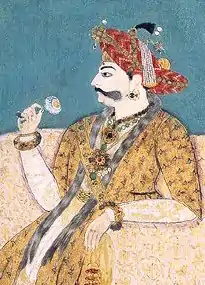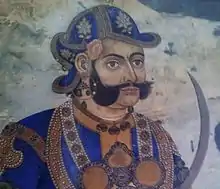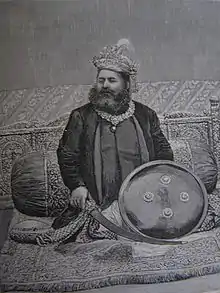Singh
Singh (IPA: /ˈsɪŋ/) is a title, middle name, or surname that means "lion" in various Indo-Iranian languages.
The name has been adopted as a title by some warriors, such as Rajputs.[1] The name was mandated in the 18th century by Sri Guru Gobind Singh Ji for all male Sikhs. It has also been adopted by several castes and communities. As a surname or a middle name, it is now found throughout the world across communities and religious groups, becoming more of a title than a surname.[2]
Etymology and variations
The word "Singh" is derived from the Sanskrit-language word सिंह (IAST: siṃha), used in the sense "hero" or "eminent person".[3]
Several variants of the word are found in other languages:
- In Hindi and Nepali, the name is written सिंह, and pronounced IPA: [sɪŋɡʱ].
- In Odia, the name is written as 'ସିଂ' (Pronounced as sing) or 'ସିଂହ' (Pronounced as Singha or Sinha).
- In Bengali, the name is written as সিংহ (Sing-ho) which also means lion, however the name is pronounced as Shingh.
- In Punjabi (Gurmukhi script/Shahmukhi script), the name is written as ਸਿੰਘ/سِنگھ and pronounced as Singh.
- In Urdu, it is written as سِنگھ with the same pronunciation. Variations include Simha and Sinha in Bihar.[4]
- In Maithili, the name is written as सिंह and both Singh and Sinha are used interchangeably.
- In Marathi, the name is written and pronounced as सिंह (Sinha).
- In Gujarati, it is spelled as સિંહ (Sinh) and pronounced ['sĩɦ].[5] Another variant is Sinhji, where the suffix of respect 'ji' is added.
- In Shina, it is spelled as سِنگھ.
- In Chinese, Shīzi (狮子) means lion.
- In Telugu, the word for lion is simham (సింహం).
- In Malayalam, simham (സിംഹം) means lion.
- In Meitei, the name is written and pronounced as Singh or (ꯁꯤꯪꯒ), although many meitei communities are shifting back to the traditional naming system. The Bishnupuri Manipuri people use Sinha (সিনহা) or Singha(সিংহ).
- In Tamil, the name is Singham written as சிங்கம்.
- In Singhala, the name is written සිංහ and pronounced Singha.
- In Burmese, it is spelled သီဟ (thiha), derived from the Pali variant siha.
- In Thailand, singha is known as sing (สิงห์), meaning "lion".
- In Indonesia and Malaysia, Singa or Singha, means lion.
- In Kannada the name is simha and written as ಸಿಂಹ.
History

Originally, the Sanskrit word for lion, variously transliterated as Simha or Singh was used as a title by Kshatriya warriors in northern parts of India. The earliest recorded examples of the names ending with "Simha" are the names of the two sons of the Saka ruler Rudraraman in the second century CE. Jayasimha, the first ruler of the Chalukya dynasty to bear the title Simha, ruled around 500 CE. The Vengi branch of the Chalukyas continued using Simha as the last name till the eleventh century. The Rajputs started using Singh in preference to the classical epithet of "Varman". Among the Rajputs, the use of the word Simha came into vogue among the Paramaras of Malwa in 10th century CE, among the Guhilots and the Kachwahas of Narwar in the 12th century CE, and the Rathores of Marwar after the 17th century.[6]
By the sixteenth century, "Singh" had become a popular surname among Rajputs.[7] It was adopted by the Sikhs in 1699, as per the instructions of Sri Guru Gobind Singh Ji. Singh is used by all baptized male Sikhs, regardless of their geographical or cultural binding; the women use Kaur.[8][9]
In the 18th century, several groups started using the title "Singh". These included the Brahmins, the Kayasthas and the Baniyas of what are now Uttar Pradesh and Bihar. In the 19th century, even the Bengal court peons of the lower castes adopted the title "Singh".[6] Bhumihars, who originally used Brahmin surnames, also started affixing Singh to their names.[10] In Bihar and Jharkhand, the surname came to associated with power and authority, and was adopted by people of multiple castes, including Brahmin zamindars.[11] Ahir (Yadav) and Kurmis used 'Singh' as part of their name.[12]
People belonging to several other castes and communities have also used Singh as a title, middle name or a surname; these include non-Sikh Punjabis, Gujjars (e.g. Nirbhay Singh Gujjar), Marathas (e.g. Pratap Singh Rao Gaekwad) and Hindu Jats, (e.g. Bhim Singh Rana), Sikh Jats,(e.g. Maharaja Ranjit Singh). The surname 'Singh' is used by many caste groups in Bihar.[13] The name is also found among the Indian diaspora. For example, taking advantage of the fact that there was no reliable way to ascertain a person's caste, some of the low-caste Indian indentured labourers brought to British Guiana adopted the surname "Singh", claiming to be high-caste Kshatriyas.[14]
Usage
"Singh" is generally used as a surname (e.g. Manmohan Singh or Yuvraj Singh) or as a middle name/title (e.g. Mulayam Singh Yadav, Mahendra Singh Dhoni). When used as a middle name, it is generally followed by the caste, clan or family name. Rajputs may have "Singh" as middle name or last name (e.g. Manish Singh Parmar)[15] To stop the practice of caste system in Sikhism, some Sikhs append "Khalsa" to Singh (e.g. Harinder Singh Khalsa). Some Sikhs add the names of their native villages instead (e.g. Harcharan Singh Longowal, after Longowal).[16]
Originally, a common practice among the Rajput men was to have "Singh" as their last name, while Rajput women had the last name 'Kanwar'. However, now, many Rajput women have Singh in their name (e.g.Prashanti Singh) as well.[17]
Outside South Asia
A section of around a million adherents of Sikhism that live abroad in Western countries only keep Singh or Kaur as their last name. This has caused legal problems in immigration procedures, especially in Canada. For a decade, the Canadian High Commission in New Delhi stated in letters to its Sikh clients that "the names Kaur and Singh do not qualify for the purpose of immigration to Canada", requiring people with these surnames to adopt new ones. The ban was denounced by the Sikh community, after which the Citizenship and Immigration Canada announced it was dropping the policy, calling the whole issue a misunderstanding based on a "poorly worded" letter.[18]
See also
- List of people with surname Singh
- Singh v Canada, a Supreme Court of Canada case on the applicability of Charter rights to refugee claimants
- Sinha
- Kaur
References
- Angus Stevenson; Maurice Waite (2011). Concise Oxford English Dictionary: Book & CD-ROM Set. OUP Oxford. p. 1346. ISBN 9780199601103.
- Kumar Suresh Singh (1996). Communities, segments, synonyms, surnames and titles. Anthropological Survey of India. p. 32. ISBN 9780195633573.
Going by the usage, Singh is more a title than a surname, cutting across communities and religious groups.
- Patrick Hanks, ed. (2003). Dictionary of American Family Names. Oxford University Press, USA. p. 354. ISBN 978-0-19-508137-4.
- Vanita, Ruth (2005). Gandhi's tiger and Sita's smile: essays on gender, sexuality and culture. New Delhi: Yoda Press. p. 37. ISBN 978-81-902272-5-4. OCLC 70008421.
- "સિંહ". Wiktionary. Retrieved 01 May 2020.
- Qanungo, Kalika Ranjan (1960). Studies in Rajput History. Delhi: S. Chand. pp. 138–140. OCLC 1326190.
- Prakash Chander (1 January 2003). India: Past & Present. APH Publishing. p. 120. ISBN 978-81-7648-455-8. Retrieved 11 January 2013.
In those days, "Singh" as a surname was very popular among a famous warrior caste of north India, the Rajputs. Some of the first Sikhs were also Rajputs.
- A History of the Sikh People (1469-1988) by Dr. Gopal Singh ISBN 81-7023-139-6
- Catherine B. Asher; Cynthia Talbot (2006). India Before Europe. Cambridge University Press. p. 269. ISBN 9780521809047.
- Virendra Prakash Singh (1992). Community And Caste In Tradition. Commonwealth. p. 113. ISBN 9788171692422.
- Pranava K Chaudhary (2009-02-21). "Using surnames to conceal identity". The Times of India. Retrieved 2013-01-18.
- Bhavan's Journal, Volume 12, Issues 1-16. 1965. p. 123.
- Singh, Santosh (2015). Ruled or Misruled: Story and Destiny of Bihar. Bloomsbury Publishing. ISBN 9789385436420. Retrieved 28 July 2016.
- Raymond Thomas Smith (1996). The matrifocal family: power, pluralism, and politics. Routledge. p. 118. ISBN 0-415-91214-8.
- Khushwant Singh, A History of the Sikhs, Volume I
- B. V. Bhanu Contributors Kumar Suresh Singh, B. V. Mehta, Anthropological Survey of India (2004). People of India: Maharashtra, Part 3. Popular Prakashan. p. 1846. ISBN 9788179911020.CS1 maint: multiple names: authors list (link)
- Kolff, Dirk H.A., The Rajput of Ancient and Medieval North India: A Warrior-Ascetic; Folk, Faith and Feudalism, edited by NK Singh and Rajendra Joshi, Institute of Rajasthan Studies, Jaipur, India. Rawat Publications, Jaipur and New Delhi. ISBN 81-7033-273-7
- San Grewal (2007-07-26). "'Singh' ban denounced". Toronto Star.




